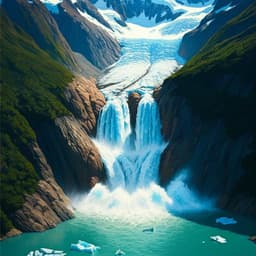
Earth Sciences
Nuclear Niño response observed in simulations of nuclear war scenarios
J. Coupe, S. Stevenson, et al.
This study reveals how smoke from nuclear war fires could trigger a significant climate response in the equatorial Pacific Ocean, leading to a drastic reduction in phytoplankton productivity and an extreme climate impact lasting up to seven years. Conducted by Joshua Coupe, Samantha Stevenson, and their colleagues, it highlights the potential for nuclear war to severely disrupt environmental stability and food security.
~3 min • Beginner • English
Introduction
The study investigates how smoke-induced radiative cooling from nuclear war could perturb the coupled ocean–atmosphere system, with a focus on the tropical Pacific and ENSO dynamics. Motivated by renewed geopolitical risk and the critical role of marine resources for global food security following agricultural collapse, the authors ask whether nuclear-war-driven aerosol forcing could trigger an El Niño-like response and how this would affect ocean circulation and biogeochemistry. Prior research shows stratospheric aerosols from volcanoes can favor El Niño in the following years, yet the ENSO response to nuclear-war soot, with longer atmospheric residence time and stronger forcing, has been largely unexplored. The purpose is to simulate a suite of nuclear war scenarios using a comprehensive Earth system model to characterize the physical Nuclear Niño response, identify its mechanisms, and quantify impacts on equatorial Pacific net primary productivity (NPP).
Literature Review
Past work during the 1980s established the nuclear winter hypothesis, with soot lofted to the stratosphere causing prolonged surface cooling and stratospheric heating. Subsequent modeling confirmed strong cooling from smoke injections after nuclear conflict and highlighted risks to agriculture and food security. ENSO is known to be sensitive to external forcings: paleoclimate evidence and models show tropical volcanic eruptions increase El Niño likelihood in the subsequent 1–2 years, often followed by La Niña. Geoengineering with stratospheric aerosols has been associated with a slight increase in El Niño probability and an El Niño-like decadal mean state shift. Mechanisms proposed for aerosol-induced El Niño include: equatorward ITCZ shift due to interhemispheric temperature gradients; cooling of the Maritime Continent reducing the west–east SST gradient; Kelvin waves triggered by cooling over tropical Africa; and the ocean dynamical thermostat that moderates eastern Pacific cooling via upwelling. ENSO state dependence also matters for post-forcing evolution. In marine biogeochemistry, El Niño typically depresses equatorial Pacific productivity via thermocline deepening and reduced upwelling, with major fishery impacts in eastern boundary upwelling systems; however, post-volcanic biological responses have varied across models, sometimes showing later enhancements during La Niña-like rebounds.
Methodology
The authors use the Community Earth System Model (CESM v1.3) with WACCM4 as the atmospheric component (CESM-WACCM4) coupled to the POP2 ocean model with the Biogeochemical Elemental Cycling (BEC) model. The atmosphere is run at ~1.9°×2.5° with 66 vertical levels and a 140 km model top. CARMA, a sectional aerosol model coupled to WACCM4, represents black carbon soot as fractal particles across 21 size bins with evolving optical properties via coagulation; interactive stratospheric chemistry allows ozone depletion under stratospheric heating. Simulations begin in year 2000 with CO2 fixed at 370 ppm. Six nuclear war scenarios are simulated for 15 years each: one US–Russia case with 150 Tg black carbon injected between 300–150 hPa over those countries during 7 days starting May 15 (NW-150Tg), and five India–Pakistan cases with soot loads of 46.8, 37, 27.3, 16, and 5 Tg (the 5 Tg case has three ensemble members). Table 1 summarizes weapons, yields, and soot loads used to construct scenarios, following Robock et al. and Toon et al. Control runs (three ensembles) are 20 years each and provide climatology. Sensitivity experiments isolate mechanisms by imposing regional surface cooling via increased surface albedo equivalent to the shortwave reduction diagnosed in NW-150Tg: EXP-MC (Maritime Continent: 95°E–140°E, 15°S–15°N), EXP-TA (tropical Africa: 15°E–50°W, 10°S–30°N), and EXP-NH (Northern Hemisphere north of 10°N excluding EXP-MC/EXP-TA regions). The albedo perturbation δα is computed from daily shortwave radiation anomalies and a cloud correction factor derived from monthly clear-sky vs all-sky fluxes. Diagnostics include zonal wind stress over 130°E–120°W (5°S–5°N), Niño3.4 SST anomalies relative to 20°S–20°N tropical mean, zonal sea surface height gradient (east 150°W–90°W minus west 140°E–170°W, 5°S–5°N), vertical velocity in the top 100 m (positive upwelling), SOI, and a mixed-layer heat budget. Biogeochemistry uses BEC with three phytoplankton classes and one zooplankton; primary production depends on biomass and specific photosynthetic division rates limited multiplicatively by temperature, light, and the most limiting nutrient (Liebig minimum among N, P, Si, Fe). Population-averaged, biomass-weighted diagnostics are computed over the upper 150 m to evaluate limitation terms, division rates, biomass, and NPP; additional diagnostics separate effects of deeper mixed layers vs PAR reduction on light limitation.
Key Findings
- Radiative forcing and global climate: In the 150 Tg case, monthly global mean downwelling solar radiation decreases by nearly 120 W m−2, producing almost 10 °C global mean surface cooling within two years. Spatially, most regions cool and dry strongly, except the equatorial Pacific which shows mild cooling and increased precipitation consistent with an El Niño-like state.
- Nuclear Niño emergence and persistence: All scenarios exhibit a rapid westerly surface wind stress anomaly over the western/central equatorial Pacific beginning within a month of injection, peaking around July–September. In NW-150Tg, westerlies persist up to seven years, with intermittent trade wind reversals for three years. The zonal sea surface height gradient flips sign (positive), indicating thermocline deepening in the east/central Pacific, and equatorial upwelling is shut down or reversed. The SOI plunges by seven standard deviations within six months in scenarios with ≥16 Tg soot, an extreme collapse of the Pacific Walker Circulation beyond historical or model control variability.
- SST response: Despite basin-wide cooling, Niño3.4 SSTs relative to the tropical mean warm for seven years in NW-150Tg, exceeding normalized amplitudes of the 1997–98 and 2015–16 El Niño peaks.
- Forcing magnitude dependence: The 27.3 Tg case (~18% of soot mass) produces >60% of NW-150Tg’s wind response, with saturation in wind stress amplitude beyond ~27.3 Tg; larger soot loads primarily extend event duration. The 5 Tg ensemble shows anomalous westerlies persisting nearly two years but lacks a multi-year El Niño.
- Role of initial ENSO state: In three 5 Tg ensembles initialized with neutral, La Niña-like, and developing El Niño states, El Niño develops in all; adding 5 Tg soot to a developing El Niño increased strength by ~25% and duration by ~2 months relative to control, indicating initial state modulates but does not preclude El Niño onset.
- Mechanisms of initiation (sensitivity tests): Cooling the Maritime Continent (EXP-MC) generates the strongest initial westerly wind stress (71% of NW-150Tg during JAS; later NDJ peak surpasses NW-150Tg), initiates convection suppression and Walker Circulation disruption, and produces robust Niño3.4 warming. Cooling tropical Africa (EXP-TA) induces an eastward-propagating equatorial Kelvin wave via West African monsoon collapse, yielding a significant but weaker wind stress (31% of NW-150Tg in JAS; NDJ peak ~44% of EXP-MC) and notable eastern Pacific warming, aided by an Atlantic Niña-like pattern. Northern Hemisphere cooling (EXP-NH) yields the weakest wind stress (~29–30% of NW-150Tg), via equatorward ITCZ retention. A brief, localized initial La Niña-like response in the eastern Pacific from faster South American cooling lasts <6 months. The ocean dynamical thermostat is not the initiator; initial zonal SST gradient and westerlies both increase, and soot-forced vertical temperature structure inhibits thermostat behavior.
- Biogeochemical impacts: In years 2–5 post-conflict for NW-150Tg, annual-mean NPP declines by ~37% (to ~155 g C m−2 yr−1) in the Eastern Equatorial Pacific biome and ~34% (to ~186 g C m−2 yr−1) in the Peru EEZ; monthly NPP reductions in the Peru EEZ often exceed 50% and reach 68% (~200 g C m−2 yr−1). Mechanistically, reduced incident PAR dominates enhanced light limitation (~50% more limiting year 1), compounded by cooling and deeper mixed layers. Iron remains the most limiting nutrient, but iron limitation is partially relieved due to deeper mixing and reduced uptake, so nutrient relief cannot offset light and temperature limitations. Population-specific division rates drop ~25% on average over five years, biomass decreases ~15%, producing ~34% NPP reduction. Smaller soot scenarios show qualitatively similar mechanisms with proportionally smaller magnitudes.
Discussion
The simulations reveal a distinct and extreme ENSO mode triggered by soot-induced radiative forcing: a multi-year El Niño-like state—Nuclear Niño—far exceeding amplitudes and persistence observed in modern or paleoclimate records and stronger than responses to volcanic sulfate aerosols due to soot’s longer residence time and stronger surface dimming. Nuclear Niño modifies tropical Pacific circulation for years, with collapsed Walker Circulation, westerly wind anomalies, deepened eastern/central Pacific thermocline, and suppressed upwelling. Mechanistic sensitivity tests indicate that suppression of convection over the Maritime Continent is the primary initiator, with significant contributions from cooling over tropical Africa (and Atlantic–Pacific coupling) and a smaller contribution from an equatorward ITCZ shift; interactions among mechanisms are nonlinear and saturate at high forcing. The biogeochemical consequences are severe: light-driven reductions in NPP, exacerbated by reduced upwelling, stress ecosystems beyond natural variability, with expected declines in fishery productivity in regions such as the Peru–Chile upwelling system and the broader equatorial Pacific. Unlike many volcanic cases that show a rebound to enhanced productivity under subsequent La Niña-like conditions within a few years, soot’s longer persistence sustains unfavorable conditions, extending ecological and food security impacts. Termination of Nuclear Niño coincides with aerosol decay, recovery of solar flux, and rewarming of the Maritime Continent and tropical Africa, followed by a delayed rebound toward La Niña-like conditions.
Conclusion
Using CESM-WACCM4, the study introduces and characterizes the Nuclear Niño: a large, sustained El Niño-like response to nuclear-war-induced soot aerosols. It identifies the primary initiating mechanism as cooling of the Maritime Continent, with additional roles for tropical African cooling and an equatorward ITCZ shift, and demonstrates unprecedented persistence and magnitude of tropical Pacific circulation anomalies. The work further quantifies profound reductions in equatorial Pacific NPP driven predominantly by reduced light, with compounded effects from cooling and mixing, implying major risks to marine ecosystems and fisheries and compounding terrestrial agricultural losses. Future research should test robustness across climate models, refine soot emission scenarios and aerosol microphysics, better quantify teleconnections and regional ecosystem responses, and explore the sensitivity to eruption/forcing seasonality and initial ENSO state.
Limitations
- Model dependence: CESM-WACCM4 simulates stronger ENSO variability than observations; mechanisms’ relative importance may vary across models and with forcing magnitude.
- Sensitivity experiment idealizations: Regional albedo perturbations may exaggerate zonal SST gradients, and advective cooling can influence other regions, preventing perfect mechanism isolation. Linear superposition does not apply due to coupled nonlinearities and saturation of wind stress response.
- Scenario uncertainties: Nuclear scenarios rely on assumptions about weapon numbers, yields, targets, fire areas, and smoke generation per capita fuel; other nuclear states and alternative war configurations were not explicitly simulated. The probability of such wars is not assessed.
- Aerosol process simplifications: CARMA omits hygroscopic growth; aerosol–cloud interactions are approximated via diagnostic corrections.
- Biogeochemical data storage limits: Depth-integrated diagnostics are limited to the upper 150 m, though tests with extrapolated profiles did not change qualitative conclusions.
- Temporal and spatial sampling: All simulations start on May 15; sensitivity to injection season and spatial distribution, while discussed in literature, is not fully explored here.
Related Publications
Explore these studies to deepen your understanding of the subject.







